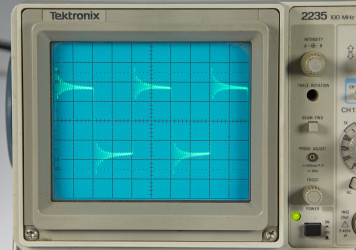Review: Function generator “in the pocket”
The ‘scope says …
Of course the smartphone drops silent when you plug in the audio connector and suddenly your eyes tell the tale on the generator signal, rather than your ears. My scope, a Tektronix 2235 from the 1980s, is analogue in essence with a CRT tube and no storage or signal processing functions of any kind. I chose it on purpose because I mistrust digital scopes displaying … digitally generated signals although in all fairness on this occasion we are dealing with “audio only” i.e. a good 20 kHz max.
I was disappointed initially by the sinewave produced by the generator — it looked spikey and noisy and I feared a bad connection somewhere. I then remembered my 2235 always has a little noise on the highest sensitivity ranges (like 20 mV /div). It’s from the internal HV generator mostly. I then realised the generator has no output amplitude indicator in volts, just a percentage readout (0-100). So I had to consult the scope to see where I was exactly. Very low, as it turned out. My initial response was to press AMPL and move the “spring response” slider to the right but this has a limited range and is slow to respond. Only then I realized I had to press the Volume Up button on my smartphone (controlling the Media volume in this case) and hey presto I was getting a strong 0.7 Vpp instead of 80 millivolts or so. This cleared the noise issue and I was able to see a clean and stable sinewave on the 2235. Burst, phase, sweep, even AM modulation all worked fine, although I was unable to determine distortion.

Sawing and squaring …
This little instrument is for use up to 22 kHz only i.e. for audio work mostly, and the makers clearly state that it is not calibrated in any respect. Amplitude indication there is none except the “0-100%” bar and yet the frequency resolution can be selected to up to 7 “significant figures”. So I used the oscilloscope graticule to set an output level of around 0.7 Vpp into 1 MΩ/47 pF and assumed the frequency to be true to the readout on the smartphone display.The sinewave and the sawtooth waveforms are both beyond reproach and suitable for quick testing I guess but the squarewave suffers from severe ringing after the rising as well as after the falling edge. The
 frequency of the damped signal (‘ripple’) is very likely an artefact of the 44.1-kHz sampling frequency of the 16-bit DAC Keuwlsoft mention as the driving force in the smartphone. The edge steepness of the pulse is poor and the tremendous ripple on the ‘roof’ makes the squarewave practically useless even for audio faultfinding let alone checking an oscilloscope’s risetime. It might just do to trigger a… Schmitt trigger. I guess the squarewave we get from the generator is “built” on the sampling principle, which goes a long way with sinewave and sawtooth but fails miserably when creating the pulse edges even at low frequencies like below 1 kHz. The ripple did not disappear after terminating the headphone outputs with a 150-Ω resistor across each of the BNC adapters on the scope inputs.
frequency of the damped signal (‘ripple’) is very likely an artefact of the 44.1-kHz sampling frequency of the 16-bit DAC Keuwlsoft mention as the driving force in the smartphone. The edge steepness of the pulse is poor and the tremendous ripple on the ‘roof’ makes the squarewave practically useless even for audio faultfinding let alone checking an oscilloscope’s risetime. It might just do to trigger a… Schmitt trigger. I guess the squarewave we get from the generator is “built” on the sampling principle, which goes a long way with sinewave and sawtooth but fails miserably when creating the pulse edges even at low frequencies like below 1 kHz. The ripple did not disappear after terminating the headphone outputs with a 150-Ω resistor across each of the BNC adapters on the scope inputs.Read full article
Hide full article

About Jan Buiting
Jan Buiting (1958) has been active in electronics and ways of expressing it since the age of 15. Attempts at educating Jan formally have so far yielded an F-class radio amateur license, an MA degree in English, a Tek Guru award, and various certificates in ele... >>


Discussion (6 comments)